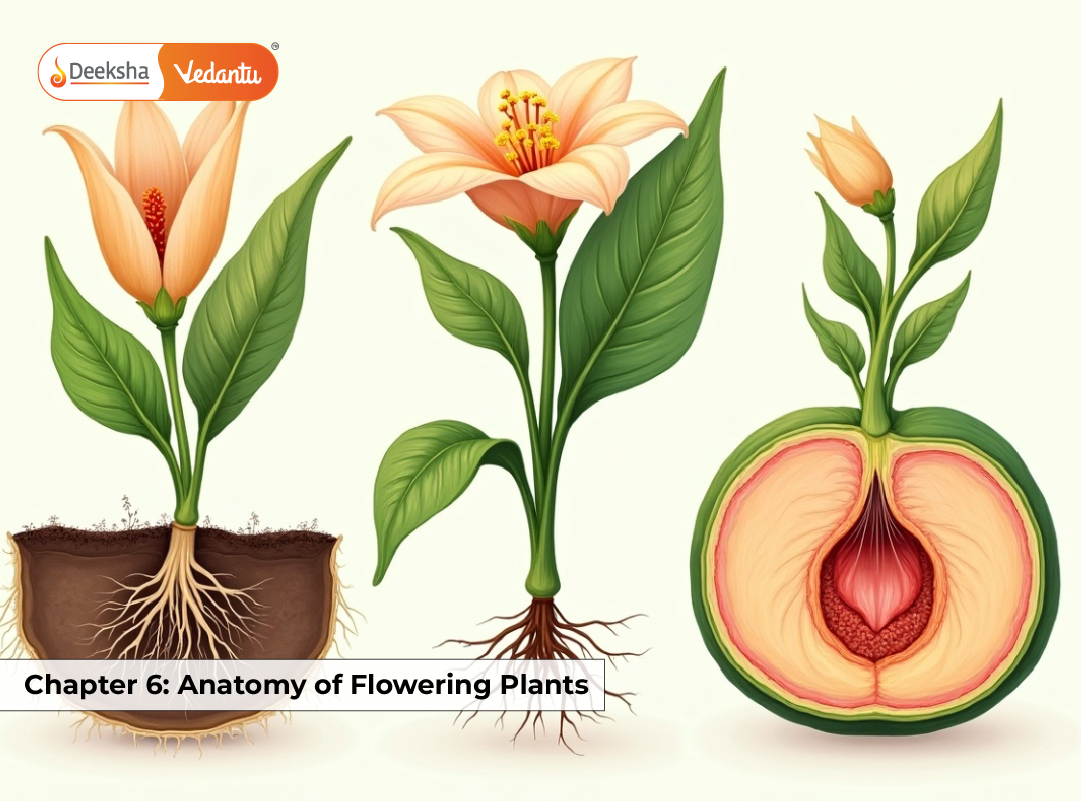Understanding the internal structure of plants is as essential as identifying their external morphology. Chapter 6 of the NCERT Class 11 Biology textbook focuses on the anatomical features of flowering plants, or angiosperms. From the microscopic arrangement of tissues to the complex process of secondary growth, this chapter offers the foundational knowledge required to master structural botany.
This chapter builds upon the fundamental concepts introduced in Unit II: Structural Organisation in Animals and Plantsand serves as a crucial continuation for students aiming to excel in the NEET exam.
For NEET aspirants, questions from this chapter often revolve around identifying tissues, comparing monocot and dicot stems/roots/leaves, and understanding secondary growth and vascular cambium. This chapter directly contributes to diagram-based and concept-driven MCQs in the exam.
Topics Covered:
- Types of plant tissues (meristematic and permanent)
- Tissue systems (epidermal, ground, vascular)
- Anatomy of dicot and monocot root, stem, and leaf
- Secondary growth (vascular cambium, cork cambium, annual rings)
NEET Tip: Nearly 2–3 questions in NEET Biology come from this chapter, especially from tissue types and secondary growth. Mastering histological features and schematic diagrams can help secure full marks from this unit.
Tissues in Plants
Plant tissues are broadly classified into two categories: meristematic tissues and permanent tissues. Each type plays a unique role in the growth, support, and transport functions of the plant.
Meristematic Tissues
Meristematic tissues are actively dividing cells that enable plants to grow. These cells are small, with dense cytoplasm and large nuclei. They are categorized based on their location in the plant body:
- Apical Meristem – Found at the root and shoot tips. Responsible for primary growth and elongation of plants.
- Intercalary Meristem – Located between mature tissues, such as at internodes or the base of leaves in monocots. It contributes to the elongation of internodes.
- Lateral Meristem – Found in mature regions of roots and shoots; responsible for secondary growth. Includes the vascular cambium and cork cambium.
Permanent Tissues
Permanent tissues arise from meristematic tissues once the cells lose their capacity to divide. They are differentiated to perform specific functions.
Simple Permanent Tissues
- Parenchyma – The most common and versatile tissue. These cells are thin-walled and loosely packed. They help in storage, photosynthesis (chlorenchyma), and buoyancy (aerenchyma).
- Collenchyma – Cells have unevenly thickened walls, offering mechanical support and flexibility to young stems and petioles.
- Sclerenchyma – Consists of dead cells with thick lignified walls. Provides maximum mechanical support. Includes fibres (elongated) and sclereids (stone cells).
Complex Permanent Tissues
- Xylem – Transports water and minerals. It has four elements:
- Tracheids and vessels – Conducting cells
- Xylem parenchyma – Storage
- Xylem fibres – Mechanical support
- Phloem – Transports food (mainly sucrose) from leaves to other parts. It has:
- Sieve tube elements – Conducting
- Companion cells – Control activity
- Phloem parenchyma – Storage
- Phloem fibres – Support
Tissue Systems in Plants
Plant tissues are organized into systems based on their structure and function. The three tissue systems are:
Epidermal Tissue System
The epidermal tissue system forms the outermost protective layer of the plant body. It plays a key role in safeguarding internal tissues against mechanical injury, desiccation, and invasion by pathogens. This system is particularly important in regulating plant-environment interactions.
Key components:
- Epidermis: A single layer of tightly packed parenchymatous cells without intercellular spaces. In aerial parts, it is often covered with a waxy cuticle to minimize water loss.
- Root Hairs: These are tubular extensions of epidermal cells in roots that significantly increase surface area for absorption of water and minerals from the soil.
- Trichomes: Hair-like outgrowths from the epidermis in stems and leaves. These can be unicellular or multicellular, glandular or non-glandular. They help reduce transpiration, reflect light, and sometimes secrete substances.
- Stomata: Pores surrounded by two guard cells that regulate gaseous exchange and transpiration. Distribution varies—dicots have more stomata on the lower surface; monocots usually have equal distribution.
Ground Tissue System
This tissue system occupies the largest volume in most plants and serves several roles such as photosynthesis, storage, and support. It lies between the epidermis and the vascular tissues.
Main tissue types:
- Parenchyma: Most abundant, thin-walled and living. Found in the cortex, pith, and mesophyll. Specialized parenchyma includes:
- Chlorenchyma: Contains chloroplasts for photosynthesis.
- Aerenchyma: Air spaces for buoyancy in aquatic plants.
- Collenchyma: Living tissue with unevenly thickened walls, usually found under the epidermis in dicots. Provides mechanical support and elasticity.
- Sclerenchyma: Composed of thick-walled, dead cells with lignified walls. Provides rigidity. Two types:
- Fibres: Long and narrow
- Sclereids: Short and irregular
In leaves, the ground tissue is known as mesophyll, differentiated into:
- Palisade parenchyma: Rich in chloroplasts, for photosynthesis.
- Spongy parenchyma: Loosely arranged with air spaces for gas exchange.
Vascular Tissue System
This system is specialized for the conduction of water, minerals, and nutrients. It comprises two complex tissues: xylem and phloem, organized into vascular bundles.
Xylem: Conducts water and minerals upward. Includes:
- Tracheids and vessels: Main conducting elements.
- Xylem parenchyma: Stores food.
- Xylem fibres: Provide mechanical strength.
Phloem: Transports organic solutes (mainly sugars) from leaves to other parts. Includes:
- Sieve tube elements and companion cells: Main conducting unit.
- Phloem parenchyma: For storage.
- Phloem fibres: Only dead components, for support.
Vascular bundle arrangements:
- Conjoint: Xylem and phloem are together in the same bundle.
- Collateral: Phloem is located only on the outer side of xylem.
- Bicollateral: Phloem is present on both inner and outer sides of xylem (e.g., in Cucurbita).
- Radial: Xylem and phloem are arranged alternately on different radii (common in roots).
These three systems—epidermal, ground, and vascular—are intricately organized and vary in structure based on plant organ and type (monocot/dicot), making them important for both conceptual clarity and NEET-based objective questions.
Anatomy of Dicot and Monocot Plants
The internal anatomy of plants differs between dicots and monocots. Recognizing these differences is crucial for NEET.
Dicot Stem
The dicot stem has a distinct outer epidermis bearing multicellular trichomes and a continuous layer of cuticle. Beneath this lies the hypodermis composed of collenchyma that provides mechanical strength and elasticity. The ground tissue includes parenchyma for storage and transport. Vascular bundles are arranged in a ring and are conjoint, collateral, and open, allowing secondary growth due to the presence of a vascular cambium. Medullary rays are prominent and help in radial conduction.
Monocot Stem
The monocot stem exhibits an outer epidermis without hairs and a multilayered hypodermis of sclerenchyma. The ground tissue is undifferentiated and extends from hypodermis to the center. Vascular bundles are numerous, scattered throughout the ground tissue, closed (no cambium), and collateral, thus lacking secondary growth. Each vascular bundle is surrounded by a sclerenchymatous bundle sheath.
Dicot Root
The dicot root consists of an epidermis (piliferous layer), cortex (parenchymatous), endodermis with Casparian strips (made of suberin), pericycle (gives rise to lateral roots), and radial vascular bundles. The protoxylem is exarch (facing periphery). Vascular tissues are fewer in number and arranged in a ring. A cambium ring forms later, enabling secondary growth.
Monocot Root
Similar in arrangement to dicot root but has more vascular bundles (polyarch condition). The pith is large and well-developed. Endodermis and pericycle are present. Vascular bundles are radial and exarch, but secondary growth is absent due to the lack of cambium.
Dicot Leaf (Dorsiventral)
Dicot leaves have two surfaces: adaxial (upper) and abaxial (lower). The epidermis is covered by a cuticle and bears stomata mainly on the abaxial side. The mesophyll is clearly differentiated into palisade parenchyma (columnar, photosynthesis) and spongy parenchyma (loose, gas exchange). Vascular bundles are surrounded by a parenchymatous bundle sheath.
Monocot Leaf (Isobilateral)
Monocot leaves have a uniform structure on both surfaces. Epidermis on both sides has a cuticle and stomata. Mesophyll is not differentiated into palisade and spongy parenchyma. Bulliform cells are present in groups on the adaxial surface, helping in leaf folding during water stress. Vascular bundles are surrounded by a sclerenchymatous bundle sheath.
Comparative Table
| Feature | Dicot Stem | Monocot Stem | Dicot Root | Monocot Root | Dicot Leaf | Monocot Leaf |
| Epidermis | With hairs | Without hairs | Present | Present | Upper & lower | Both surfaces |
| Hypodermis | Collenchyma | Sclerenchyma | Cortex present | Cortex present | Palisade & spongy | Undifferentiated |
| Vascular Bundles | Ring, open | Scattered, closed | Radial, exarch | Radial, exarch | Surrounded by sheath | Surrounded by sheath |
| Cambium | Present | Absent | Develops later | Absent | Absent | Absent |
| Secondary Growth | Present | Absent | Present | Absent | Absent | Absent |
Secondary Growth
Secondary growth is characteristic of dicot stems and roots. It results in an increase in girth and formation of wood.
Vascular Cambium
- Meristematic layer between xylem and phloem.
- Produces secondary xylem (wood) inward and secondary phloem outward.
- Results in formation of annual rings, used to determine plant age.
Cork Cambium (Phellogen)
- Forms in the outer cortex.
- Produces cork (phellem) outward and phelloderm inward.
- Together these form the periderm, replacing the epidermis.
- Protects the plant and reduces water loss.
NEET Tip: Focus on diagrams showing the transition from primary to secondary growth and label the cambial ring, xylem, phloem, and periderm layers.
NEET Illustrations – Key Recap
- Meristem types: Apical (growth), Intercalary (monocots), Lateral (secondary growth)
- Parenchyma → photosynthesis, Collenchyma → flexibility, Sclerenchyma → strength
- Vascular bundles: Ring in dicots, scattered in monocots
- Annual rings = secondary xylem
Illustrative NEET Questions
Q1. Which of the following tissues is dead at maturity?
- a) Parenchyma
- b) Collenchyma
- c) Sclerenchyma
- d) Phloem parenchyma
Answer: c) Sclerenchyma
Q2. The vascular bundles in a monocot stem are:
- a) Collateral and open
- b) Radial and open
- c) Collateral and closed
- d) Conjoint and open
Answer: c) Collateral and closed
Q3. Bulliform cells are found in:
- a) Dicot root
- b) Dicot stem
- c) Monocot leaf
- d) Dicot leaf
Answer: c) Monocot leaf
FAQs
1.What is the function of xylem in plants?
Xylem transports water and minerals from roots to aerial parts.
2. How can you differentiate between dicot and monocot roots anatomically?
Dicot roots have fewer xylem/phloem bundles and a cambium ring; monocot roots have many vascular bundles and no secondary growth.
3. Why is secondary growth absent in monocots?
Monocots lack vascular cambium, which is essential for secondary growth.
4. What is the significance of annual rings in woody plants?
They represent the age and environmental conditions during each growth cycle.
Conclusion
Chapter 6 provides a foundational understanding of plant anatomy, vital for recognizing tissue organization and understanding plant functions. With repeated diagram-based and direct concept questions in NEET, this chapter is indispensable for scoring well. Focus on learning structural details, mastering comparative tables, and practicing diagrams to excel in this topic.




Get Social